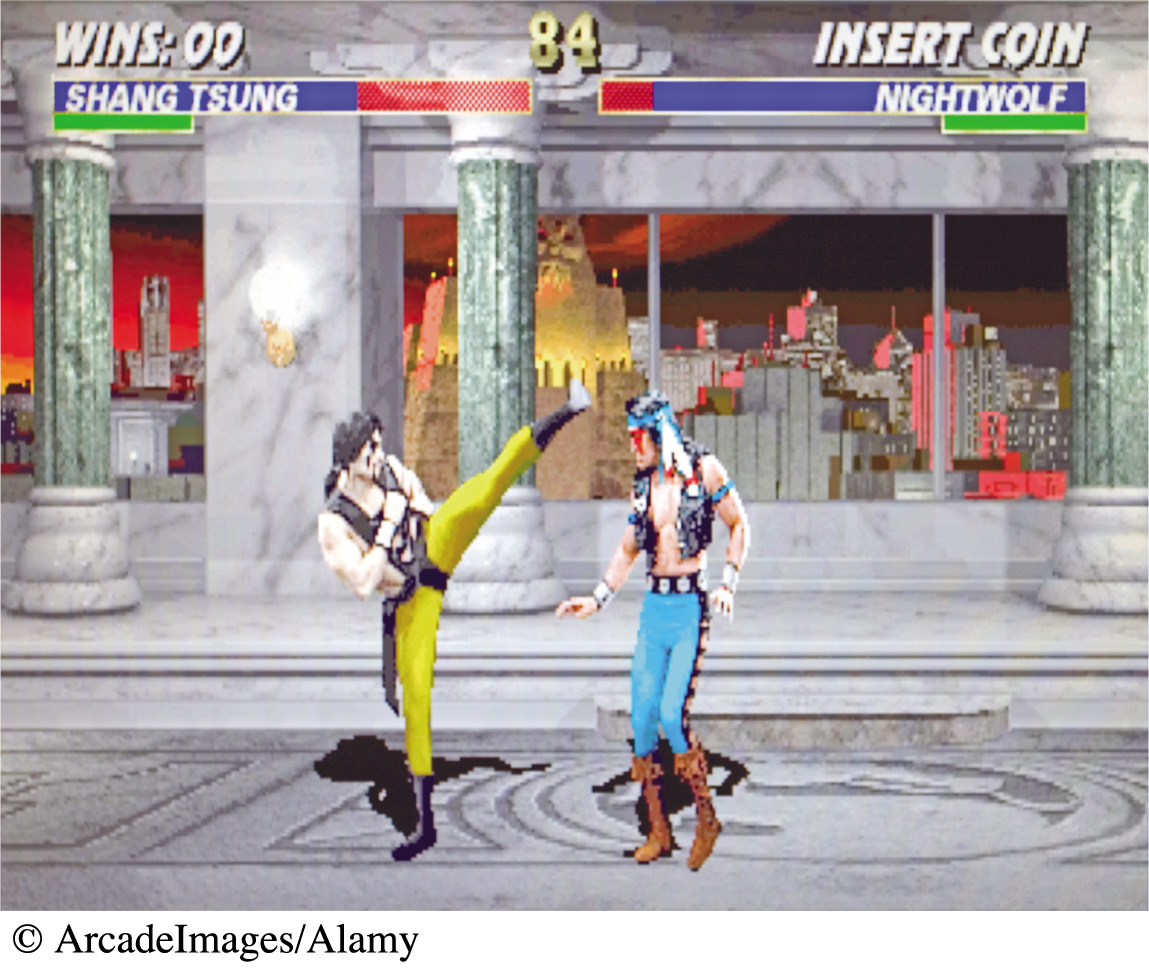Digital Gaming in a Democratic Society
Though many people view gaming as a simple leisure activity, the digital gaming industry has sparked controversy. Parents and politicians have expressed concern about the content of some games, whereas other critics say the portrayal of women and minorities in games is either nonexistent or troubling. Meanwhile, the gaming industry has argued that it qualifies for free-speech protection, and that its ratings and regulations should not necessarily bear the force of law.
Self-Regulation
Back in 1976, an arcade game called Death Race prompted the first public outcry over violence in digital gaming. The primitive graphics of the game depicted a blocky car running down stick-figure gremlins that, if struck, turned into grave markers. Described as “sick and morbid” by the National Safety Council, Death Race inspired a 60 Minutes report on the potential psychological damage of playing video games. Since then, violent video games have prompted citizens’ groups and politicians to call for government regulation of digital game content.

In 1993, after the violence of Mortal Kombat and Night Trap attracted the attention of religious and educational organizations, U.S. Senator Joe Lieberman conducted a hearing that proposed federal regulation of the gaming industry. Following a pattern established in the movie and music industries, the gaming industry implemented a self-regulation system enforced by an industry panel. The industry founded the Entertainment Software Rating Board (ESRB) to institute a labeling system designed to inform parents of sexual and violent content that might not be suitable for younger players. Currently, the ESRB sorts games into six categories: EC (Early Childhood), E (Everyone), E 10+ (Everyone 10+), T (Teen), M (Mature 17+), and AO (Adults Only 18+).19
Free Speech and Video Games
Though 80 percent of retail outlets voluntarily chose to observe the ESRB guidelines and not sell M- and AO-rated games to minors, the ratings did not have force of law. That changed in 2005, when California tried to make renting or selling an M-rated game to a minor an offense enforced by fines. The law was immediately challenged by the industry and struck down by a lower court as unconstitutional. California petitioned the Supreme Court to hear the case. In a landmark decision handed down in 2011, the Supreme Court granted digital games speech protections afforded by the First Amendment. According to the opinion written by Justice Antonin Scalia, video games communicate ideas worthy of such protection:
Like the protected books, plays, and movies that preceded them, video games communicate ideas—and even social messages—through many familiar literary devices (such as characters, dialogue, plot, and music) and through features distinctive to the medium (such as the player’s interaction with the virtual world).20
Scalia even mentions Mortal Kombat in footnote 4 of the decision:
Reading Dante is unquestionably more cultured and intellectually edifying than playing Mortal Kombat. But these cultural and intellectual differences are not constitutional ones. Crudely violent video games, tawdry TV shows, and cheap novels and magazines are no less forms of speech than The Divine Comedy…. Even if we can see in them “nothing of any possible value to society” … they are as much entitled to the protection of free speech as the best of literature.21
However, as in the music, television, and film industries, First Amendment protections will not make the rating system for the gaming industry go away. Parents continue to have legitimate concerns about the games their children play. Game publishers and retailers understand it is still in their best interests to respect those concerns, even though the ratings cannot be enforced by law.
Alternate Voices
While historically much of the concern over video games has focused on portrayals of general violence, in recent years there has been a growing criticism about the portrayals of women and minorities in gaming and gaming culture. As discussed in the opening of this chapter, about half of gamers are female and are increasingly skewing older. This has prompted pointed questions from gaming critics, including avid female gamers: Why aren’t more games created to appeal to women? Why don’t more heroic female avatars exist? Why are some portrayals of women so deeply disturbing? For example, critics often point out the popular game series Grand Theft Auto, which in one of its versions made it so that a character could build up health by having sex with a prostitute, and then get his money back by killing the woman. Other critics also point to the lack of heroic representations of nonwhite characters.
That’s not to say there aren’t games being written from other perspectives. Online funding sites like Kickstarter and Patreon are helping independent game artists write and develop their own games. Some examples include Depression Quest, a nontraditional game that uses a multiple-choice text adventure to simulate the experience of having depression, or Gone Home, which engages LGBT issues.22 These games, although nowhere near as well known as top-tier box games or casual games, have received good reviews in the gaming press.
Decades ago, groundbreaking critical cultural scholar Stuart Hall wrote that even though popular television wasn’t considered “high culture” by many social critics and academics of the time, it was still very important to study and understand the cultural messages contained in television because so many people spent so much time engaged with it. He argued that when looking at an entire nation, relatively few people in a society had the time or resources required to frequent museums or attend the opera. But they did own and watch televisions.23
Perhaps a similar argument can be made about digital games. In one form or another, they are growing in popularity across ages and genders. Gamers both serious and casual spend many hours engaging with these virtual worlds, absorbing what they see and hear. Once considered a distraction, they’re now a prominent part of the mass media landscape.